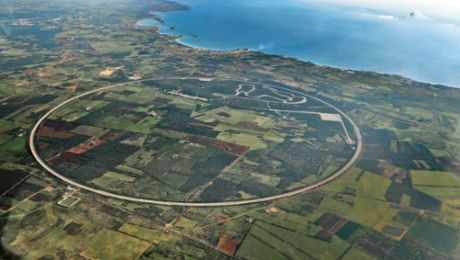The Apulian sun beats down on the asphalt mercilessly. The air shimmers above the track, which only reveals its curved shape upon a second glance towards the horizon and banks inwards at up to 12 degrees like the rim of a bowl. “La Pista di Nardò”—the place where car legends are made.
This perfect asphalt circle has been the site of many records since it was opened in 1975: There have been hun-dreds of them in the last few decades. Yet the circular track was never a race track, but has long been used for testing purposes. The ideal conditions for tests on the four lanes of the circle allow speeds that would only be feasible elsewhere with considerably more difficulty. Precisely 387.87 kilometers per hour was the top speed reached by the Koenigsegg CCR—and that at the end of February 2005, the heart of the meteorological winter. And that’s not even the limit: In 1979, a Mercedes-Benz C1 topped out at a speed of 403.98 km/h.
One of the great advantages of Nardò is the climate
“One of the great advantages of Nardò is the climate: Tests can be run here in Apulia throughout the year; rainy days and frost are extremely rare,” explains Francesco Nobile, Managing Director of the Nardò Technical Center. Nobile is well acquainted with the assets of the track regarded by experts as the fastest circuit in the world – as well as those of its other facilities. The circular track with its four parallel lanes plus interior emergency lane allows top speeds with minimal vertical forces and thus low tire wear, enabling cars to drive at a blistering pace while maintaining optimal control: In the outermost lane, lane four—like the other three lanes four meters wide—thanks to the banking cars can drive at up to 240 kilometers per hour without having to steer to stay on course.
Lane three allows the same at up to 193 km/h, lane two creates the sensation of a straightaway at up to 140, and the first lane next to the innermost emergency lane allows 100 km/h without touching the steering wheel. This uniform construction with its perfectly maintained radius and slope of the track essentially preclude unidirectional forces during driving. And of course, higher speeds are possible without having to reckon with premature wear of tire materials due to unfavorable track conditions: Up to 500 kilometers per hour are possible. That the Pista di Nardò was designed and built this way in the 1970s can only be regarded as visionary and forward-looking for its time. Indeed, even today, in 2012, the grounds are still perfectly suited for testing current and future cars of all classes. Experts concur that not even the legendary oval in Fontana, California, the Auto Club Speedway, can compare.
The unique circular track is complemented by its auxiliary facilities: A unique handling track that includes hills and compressions to test the limits of the vehicle material is as much a part of the Nardò Technical Center as a vehicle dynamic track, a track with various surfaces, dirt and gravel tracks, as well as a noise test track for a diverse array of testing requirements. And the tracks are supplemented by the necessary infrastructure: Workshops for test teams that have booked track time are available on the 700 hectare grounds.
The complex in Nardò now belongs to the Porsche Group
Opened by Fiat in in 1975, the grounds were sold to Prototipo SpA by the Italian government in 1999 and managed by the company until 2012. Use of the facility has been open to all manufacturers since the beginning. Since May of this year, the complex in the province of Lecce has belonged to the Porsche Group—but continues the tradition of over 80 years of Porsche history in customer projects and remains open to all manufacturers. The facility adds yet a new element to the engineering service portfolio offered by the Porsche Group. Customers that have called on the development skills of Porsche Engineering ›engineers through computer simula-tions, on sophisticated test benches and on the test track in Weissach can now have Porsche Engineering engineers test whether their product can withstand the toughest real-world forces on the test tracks at Nardò.
Full speed stability over long distances, the performance of brake systems, the reliability of individual components in real, integrated system deployment, thermal characteristics and many other factors can be tested under ideal conditions at the Nardò Proving Ground. Complete vehicle expertise is constantly being expanded at Porsche Engineering.
Since July 2012, connections with various alternating currents up to 125 amperes have been available. This enables manufacturer-specific charging stations for full-scale testing of electric vehicles. This enables not only e-mobility test drives under extreme climatic conditions in temperatures of up to 40 degrees Celsius. The charging station, which can be converted to DC upon request, also enables high-speed battery-driven endurance tests to deliver robust, substantiated data from real driving conditions.
Porsche Engineering plans to expand its possibilities
The range of possibilities on and around the circular track in Nardò is practically inexhaustible—to the benefit of Porsche Engineering customers, who now have the opportunity to move forward with a service provider that can provide a complete package of development and testing at the very pinnacle of excellence in terms of expertise and testing options. And plans are underway to expand those options in the near future: Surfacing work is planned; the vehicle dynamics course may be enlarged to enable danger-free testing of extreme maneuvers; and a wet handling area is under consideration. The objective is to maintain and expand the commanding lead the Pista di Nardò holds over other test tracks.
If the Pista di Nardò is a technical masterpiece for the automotive world, the region beyond the track also boasts plenty of attractions: The Pista’s surroundings invite visitors to enjoy the ample charms of Apulia after a successful day of testing. The complex is located a mere three kilometers from the Mediterranean. Lodgings of various types and classes are abundant, as is the justly famous cuisine of southern Italy.
And there is no shortage of attractions: Apulia is a cultural hotbed rich in history. From the remnants of the “Magna Graecia,” the ancient Greek colonial realm, to buildings from the time of Frederick II or natural phenomena like the “gravine,” deep valleys cut into the limestone of the Murge plateau, there is much to see in Apulia. Other attractions include the “trulli,” the whitewashed round stone buildings with conical roofs in and around Alberobello. Travel and transport of goods to the Apulia region is quickest and most convenient via the international airport in Brindisi, which is just about 65 kilometers from the testing grounds. Somewhat farther north, the international airport in Bari serves various airlines.
Info
Text first published in Porsche Engineering Magazine, Nr. 1/2013


